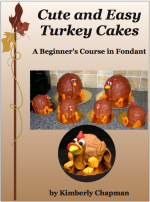At this year’s Austin cake show I will be teaching a hands-on version of my popular beginner Fondant Figure Modelling 101 tutorial (register here) as well as an intermediate class on how to make your figures look like they were frozen in the middle of actually doing something. I see too many wonderfully done cakes with figures sitting there, staring into space vacantly. No more, I say! Let’s get those sweet little people up and moving!
In my new Dynamic Figure Modeling (No More Dead-Eye Static Figures!) class, I’ll show you how to make wire armatures, tips for getting the fondant on the armature, and many more tips and tricks for adding poses and facial expressions. Each student can pick between a walker, a runner, and a jumper to work on in class but will receive a booklet on how to do all three.

The walker and jumper in front with the runner in back.

The runner in front and the others in back.
All students for this class should be comfortable with basic figure modelling and may wish to take the 101 class first. It’s pretty much the same figure, but we’re making it get up and move around.

The walker will be the easiest because it has two feet attached to the base. Choose this if you’re still pretty new to figure making.

The runner only has one foot on the ground so takes more skill. Choose this one if you are confident in your figure modelling and want to start pushing your skills. Also note that the runner is an excellent discussion point for how the face tells the story: here, this runner is scared and fleeing, but we’ll talk about how a different expression makes the same figure a happy jogger, a menacing chaser, etc.

The jumper is the most advanced of the three. It only has one foot on the ground and the posing, facial expression, and movement details are what sell the motion as jumping versus dancing. We’ll also talk about how you can use other elements of the cake to enhance the figure’s story: this would look even more “jumpy” posed on a trampoline that is indented from the force of the jump.
This class will focus on the construction and how to alter details to create different poses and moods, but also how to save time to spend on the details that matter versus those that don’t. For instance, these samples don’t have the smoothest, cleanest clothes, but their clothing is modelled to suggest movement. Hand details are more important for some poses than others. We’ll talk about how to focus your time to get the maximum effect on your figures, when it’s important to go crazy with detail, and when it’s okay to simply suggest elements in a less refined way.

Mounting hands on a wire armature is tricky and the method varies by how much detail you need. Here, a mitten-hand is stuck on and then fingers suggested with simple lines because the hands on this figure aren’t as important as they may be on a figure with hands as a focal point.
All supplies will be provided, including wire so you can learn to make armatures and cover them. This class isn’t about a specific figure, it’s about learning techniques so you can go out and make any figure you need.

The runner’s wire armature. This is very sturdy for construction.

The runner partly covered. We won’t fuss with perfect pants and shirts in this class, but we’ll talk about how to do that for when it counts, and how to position the clothing to enhance the appearance of movement.
But I hear many of you crying out, “KIM! I don’t live close enough to Austin to come to your fabulous cake show! I want this class so badly but I can’t get there! What about me?”
There are two answers: 1) if you’re involved with another cake show/club and want me to come to you, I may be able to do that. Get your show/club to invite me out to teach there. I do require that travel costs be covered and keep in mind I have a small infant so I need lots of advance warning. 2) I will make the handout for this class available for sale on this blog starting a day or two before the show. It will be $10 for a PDF of the same thing I’ll be giving out in the class, showing how to make all three figures with lots of tips and tricks to empower you to go forth and bring life into your figures.
But to incentivize you all to help urge your friends who are coming to the Austin show to take the actual class, here’s a deal: for every person signed up for this class by the close of online registration, I will lower the price of the PDF by a dollar during the show to a minimum of $2. So while the PDF will be $10 most of the time, during the show weekend it could be as little as $2 if eight people sign up for the class. If you want that to happen, post a link to this blog and/or the class registration link on your social media platforms and tell your friends to take the class. Then you can get the PDF cheap and get your friend to tell you all about what they learned hands-on with an expert. Win-win.
Plus if enough people don’t sign up the class will get cancelled, and then who knows when I’ll get around to making the PDF. So really really, help me promote this if you want the instructions for yourself!
UPDATE: The class happened, here’s the ebook discounted to $4 for the first week of sale: https://www.eat-the-evidence.com/tutorials/dynamic-figure-modelling/












Hi, for figurine sculpture that has a lot details such as hair, eyebrown, teeth…etc we need a gumpaste or normal fondant? Will gumpaste too dry or dry out quickly or cracks for a beginner like me to sculpt the detail on the face? Or normal fondant is too soft do it?
Hi Mimee, gumpaste definitely lets you get finer detail, but so much depends on your skill level, how humid it is where you are, and what quality of fondant/gumpaste you're buying. I've had super-fresh Satin Ice turn out to be so soft so as to not hold detail well at all, but Satin Ice that's been sitting around a bit turn out perfectly. I'd say if you have good gumpaste and you're comfortable using it, go for it. But it's pricier in most places and does require a bit more skill and speed. On my most recent set of figures (the Jack and Jill cupcakes) I did fondant for almost everything but used gumpaste for the tiny skirt so I could flare it out super-thin in a way that fondant just can't handle. But those were not beginner-level constructions at all.